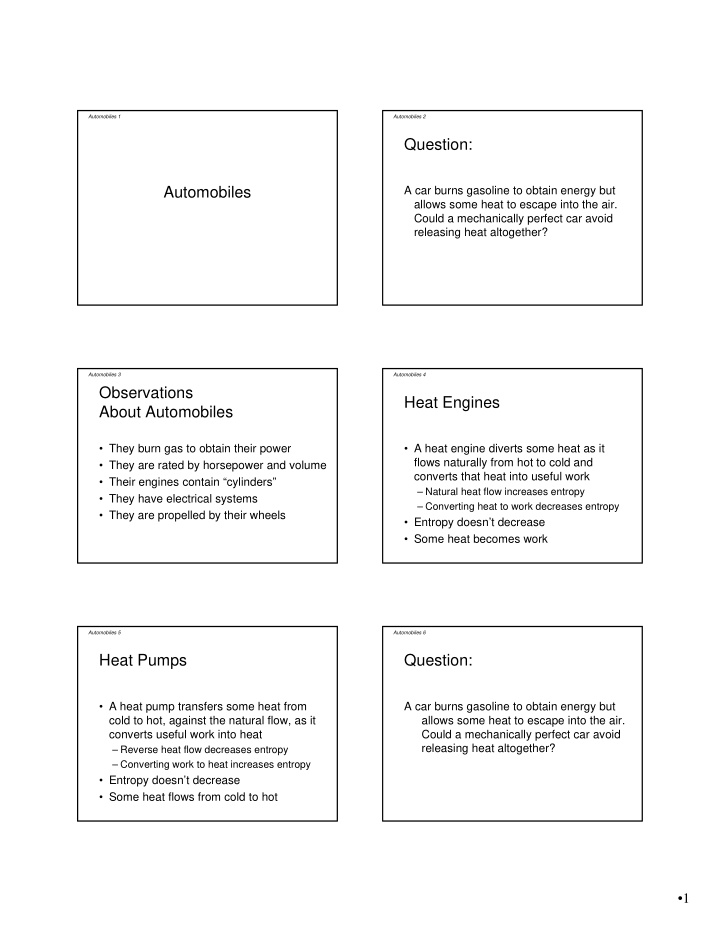



Automobiles 1 Automobiles 2 Question: Automobiles A car burns gasoline to obtain energy but allows some heat to escape into the air. Could a mechanically perfect car avoid releasing heat altogether? Automobiles 3 Automobiles 4 Observations Heat Engines About Automobiles • They burn gas to obtain their power • A heat engine diverts some heat as it flows naturally from hot to cold and • They are rated by horsepower and volume converts that heat into useful work • Their engines contain “cylinders” – Natural heat flow increases entropy • They have electrical systems – Converting heat to work decreases entropy • They are propelled by their wheels • Entropy doesn’t decrease • Some heat becomes work Automobiles 5 Automobiles 6 Heat Pumps Question: • A heat pump transfers some heat from A car burns gasoline to obtain energy but cold to hot, against the natural flow, as it allows some heat to escape into the air. converts useful work into heat Could a mechanically perfect car avoid releasing heat altogether? – Reverse heat flow decreases entropy – Converting work to heat increases entropy • Entropy doesn’t decrease • Some heat flows from cold to hot •1
Automobiles 7 Automobiles 8 Efficiency Internal Combustion Engine • As the temperature difference between hot • Burns fuel and air in enclosed space and cold increases • Produces hot burned gases – Heat’s change in entropy increases • Allows heat to flow to cold outside air – A heat pump becomes less efficient • Converts some heat into useful work – A heat engine becomes more efficient Automobiles 9 Automobiles 10 Four Stroke Engine Induction Stroke • Induction Stroke: fill cylinder with fuel & air • Engine pulls piston out of cylinder • Compression Stroke: squeeze mixture • Low pressure inside cylinder • Power Stroke: burn and extract work • Atmospheric pressure pushes fuel and air mixture into cylinder • Exhaust Stroke: empty cylinder of exhaust • Engine does work on the gases during this stroke Automobiles 11 Automobiles 12 Compression Stroke Power Stroke • Engine pushes piston into cylinder • Mixture burns to form hot gases • Mixture is compressed to high • Gases push piston out of cylinder pressure and temperature • Gases expand to lower pressure • Engine does work on the gases and temperature during this stroke • Gases do work on engine during this stroke •2
Automobiles 13 Automobiles 14 Exhaust Stroke Ignition System • Engine pushes piston into • Car stores energy in an electromagnet cylinder • Energy is released as a high voltage pulse • High pressure inside cylinder • Electric spark ignites fuel and air mixture • Pressure pushes burned gases • Two basic types of ignition out of cylinder – Classic: points and spark coil • Engine does work on the gases – Electronic: transistors and pulse transformer during this stroke Automobiles 15 Automobiles 16 Efficiency Limits Engine, Step 1 • Even ideal engine isn’t perfect • Fuel and air mixture after induction stroke – Not all the thermal energy can become work • Pressure = Atmospheric – Some heat must be ejected into atmosphere • Temperature = Ambient • However, ideal efficiency improves as – the burned gases become hotter – the outside air becomes colder • Real engines never reach ideal efficiency Automobiles 17 Automobiles 18 Engine, Step 2 Engine, Step 3 • Fuel/air mixture after compression stroke • Burned gases after ignition • Pressure = High • Pressure = Very high • Temperature = Hot • Temperature = Very hot •3
Automobiles 19 Automobiles 20 Engine, Step 4 Engine, Step 4a • Burned gases after power stroke • Burned gases after extra expansion • Pressure = Moderate • Pressure = Atmospheric • Temperature = High • Temperature = Moderate Automobiles 21 Automobiles 22 Engine, Step 4b Diesel Engine • Uses compression heating to ignite fuel • Burned gases after even more expansion – Squeezes pure air to high pressure/temperature • Pressure = Below atmospheric – Injects fuel into air between compression and power • Temperature = Ambient strokes – Fuel burns upon entry into superheated air • Power stroke extracts work from burned gases • High compression allows for high efficiency Automobiles 23 Automobiles 24 Vehicle Pollution Catalytic Converter • Platinum assists oxidization of carbon • Incomplete burning leaves carbon monoxide and hydrocarbons to carbon monoxide and hydrocarbons in exhaust dioxide and water • Accidental oxidization of nitrogen • Rhodium assists reduction of nitrogen produces nitrogen oxides in exhaust oxides to nitrogen and oxygen. • Diesel exhaust includes many carbonized • Catalysts supported on high specific particulates surface structure in exhaust duct: catalytic converter •4
Automobiles 25 Automobiles 26 Transmissions Manual Transmission • Changes force/distance (actually • Clutch uses friction to convey torque from torque/rotation rate) relationships between engine to drive shaft the engine and the wheels – Opening clutch decouples engine and shaft • Two basic types – Closing clutch allows engine to twist shaft • Gears control mechanical advantage – Manual: clutch and gears – Automatic: fluid coupling and gears Automobiles 27 Automobiles 28 Automatic Transmission Brakes • Fluid coupling uses moving fluid to convey • Use sliding friction to reduce car’s energy torque to drive shaft • Two basic types – Engine turns impeller (fan) that pushes fluid – Drum: cylindrical drum and curved pads – Moving fluid spins turbine (fan) and drive shaft – Disk: disk-shaped rotor and flat pads – Decoupling isn’t required • Brakes are operated hydraulically • Gears control mechanical advantage – Pedal squeezes fluid out of master cylinder – Fluid entering slave cylinder activates brake Automobiles 29 Summary About Automobiles • Cylinders expand hot gas to do work • Uses the flow of heat from hot burned gases to cold atmosphere to produce work • Energy efficiency is limited by thermodyn. • Higher temperatures increase efficiency •5
Recommend
More recommend